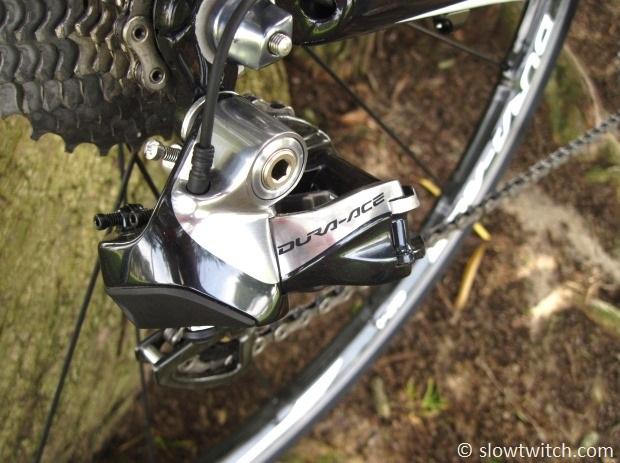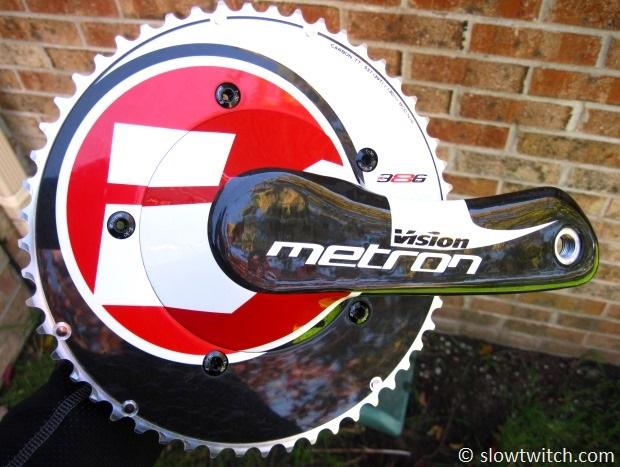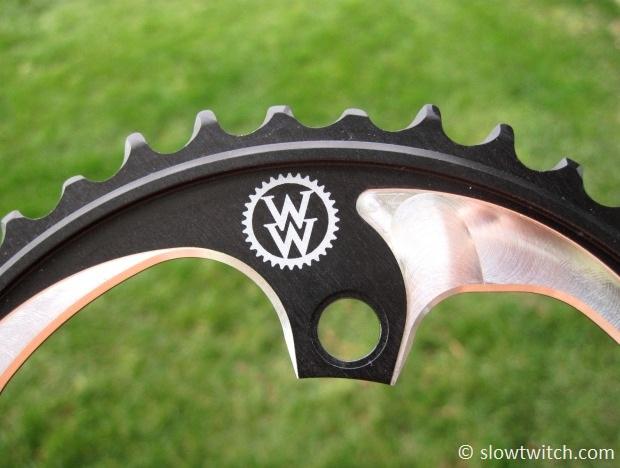Mechanical Shifting for Tri
I’ve come to learn that my personal story with mechanical and electronic shifting is actually quite common. Start with a customer that is officially a triathlete; not just someone who has done a triathlon. This person knows a fair amount about nutrition, racing, and equipment. They own a triathlon-specific bike. They might have paid for a professional fit on that bike. I could go on, but I think we have a familiar picture by now. In effect, we’re talking about almost everyone beyond the first set of casual athletes and first-timers.
When electronic shifting first came out, we didn’t quite know what to think. It looked interesting, but at least 50% of us ‘experienced athletes’ thought that it was unnecessary. It can’t actually make you faster, so it’s silly, we said.
Then, slowly, we tried it. One-by-one, we took tests rides in shops, borrowed friends’ bikes, and found ourselves reevaluating our opinions. While the reception in the road market seemed to be slightly less enthusiastic, the triathlon market quickly adopted it.
Does that mean that mechanical shifting for triathlon is a dead dog? Will every tri bike in five years feature electronic shifting? Why might you still consider mechanical shifting for your tri bike? What should you look for in order to optimize your mechanical drivetrain? Let’s investigate.
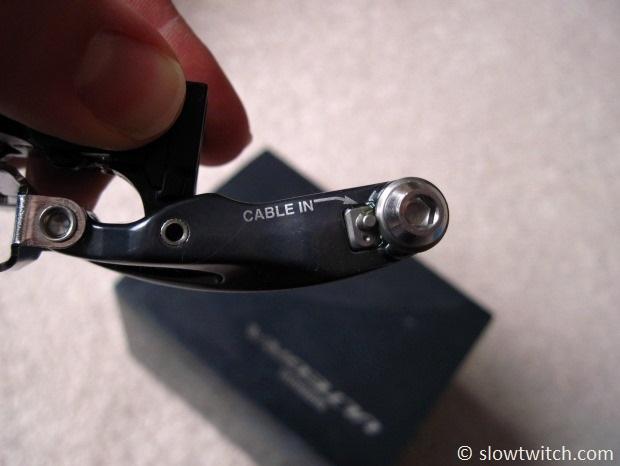
Front shifting
Front shifting is no easy task, regardless of whether your derailleur is moved by a cable or an electric motor. The chain gets swept sideways, smashed into the big ring (or on to the small ring), and is supposed to perfectly land on top without going too far. A badly executed shift can mean a dropped chain… and a pit stop to put it back on. This being the case, a well-designed chain, front derailleur, and chainrings are of utmost importance.
Shimano front shifting
The gold standard in front shifting has reigned for some time now: Shimano Dura Ace. I have owned the last three generations of this groupset (9000, 7900, and 7800), and can attest that the front shifting is the best in the biz. In fact, with both 7900 and 9000, I have never – not once – dropped a chain. It appears to be impossible when using all three critical components from these systems (FD, chain, chainrings). That may have been the case on my 7800-equipped bike, but I honestly don’t remember. I cannot say the same thing for any other component group in the entire world.
Key to Shimano’s dominance is their two-piece forged big chainring. Shimano is one of the few manufacturers to make a forged ring, and the only one to make a hollow one (that I’m aware of). It starts as two halves that are joined together, making a fantastically stiff final product. In addition, their shift ramps and pins are second-to-none. Below you’ll see the back side of a new Ultegra 6800 chainring:
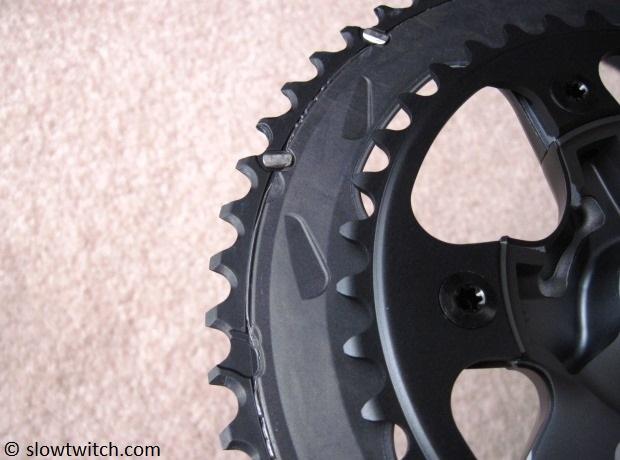
The beauty of this system is the fact that the shifts happen very fast. If you’re riding along with your hands on the base bar and want to switch chainrings, your hand must only spend a minimal amount of time on the shifter. In lieu of an electronic shifter integrated into your brake lever, this is the next best – and safest – thing. Of course, you pay a huge premium when it comes time to replace those chainrings, but you get what you pay for.
Shimano’s Ultegra line is almost as good. In my opinion, the chain and front derailleur as just as good as Dura Ace, but the chainrings aren’t quite there. The new 6800 (pictured above) can get just a tick of overshift, and chain drops can happen if you really try hard to screw it up. The best upgrade that an Ultegra customer can make is a Dura Ace crank; that effectively leaves you with a slightly heavier Dura Ace system. Likewise, an Ultegra crank is a fantastic upgrade for an otherwise 105 or Tiagra-level bike.
SRAM front shifting
SRAM’s reputation in front shifting has suffered historically, but it continues to improve with every product generation. I have used the latest 10-speed Yaw chainrings and front derailleur, but not the newer 11-speed version. At least for triathlon, this is a common situation with SRAM; our products always seems to lag behind the roadies’ stuff. I checked with SRAM’s key distributor, Quality Bicycle Products, and they expect to receive a shipment of 11-speed SRAM bar-end shifters some time in the Spring of 2014. We saw prototypes being ridden by sponsored SRAM athletes in Kona, but consumers must wait.
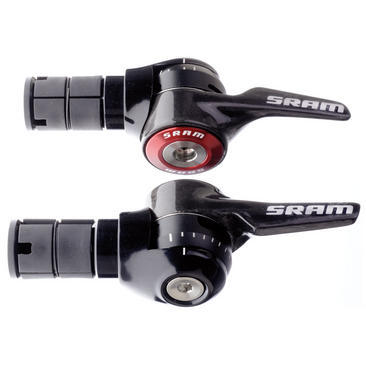
SRAM brought us the innovative R2C (Return-To-Center) shifter, which features a paddle design that always comes back to its starting position. I have ridden both the SRAM and Zipp-branded R2C shifters, but still prefer and recommend their standard paddle shifter design (TT900 carbon and TT500 aluminum).
The reason I think the standard TT shifter is better for front shifting is simple: It’s a friction-style design. When you move the shifter one centimeter, it stays there on its own. When you want to limit the time that your hand spends on the shifter – of the utmost importance in mechanical tri shifting – this behavior is exactly what you want. With the R2C shifters, you must hold that shifter in place with your hand until the shift completes. If there is any lag in the shift, you are left in an awkward position with one hand on the base bar and the other hand on the shifter. I have experienced this on rough roads, and it is not an enjoyable experience. The TT500 and TT900 shifters are free of this behavior, and work very well. Even when shifting while in the aero position, they require less time and mental energy to shift than the R2C.
SRAM’s chainrings continue to eke out better and better performance, but are not yet in the league of Dura Ace. A quick internet search showed SRAM Red 53t chainrings selling for $120, while Dura Ace 9000 goes for upwards of $300. I think SRAM makes a very nice ring for the price, but we still can’t get around that price. A single-piece machined ring is never going to perform like a two-piece forged ring, but the price point will always attract a large audience. Force, Rival, and Apex rings shift similarly, and are a good value.
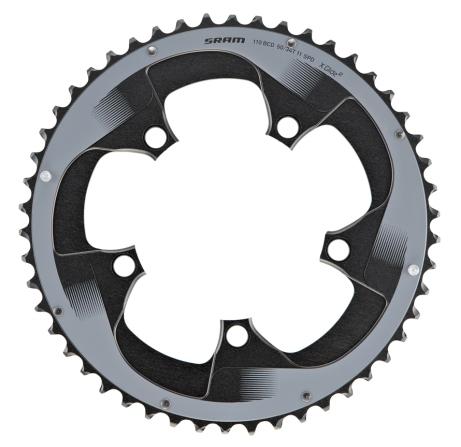
Campagnolo front shifting
It has been many years since I have personally owned a bike equipped with Campagnolo bar-end shifting. The most recent bike was an aluminum Cervelo P3 with 10-speed Chorus components. Since that time, Campagnolo brought in 11-speed, electronic shifting, a new crank design, and many other new features. I have turned quite a few wrenches on these newer systems. Similar to SRAM, it took Campagnolo some time to make a full-functioning system for us triathletes.
My experience with Campagnolo is that the front shift quality is typically somewhere between SRAM Red and Shimano Dura Ace. Mind you, this is for all standard-style cranks; I have no experience with their new Bora and Bullet Ultra aero cranks.
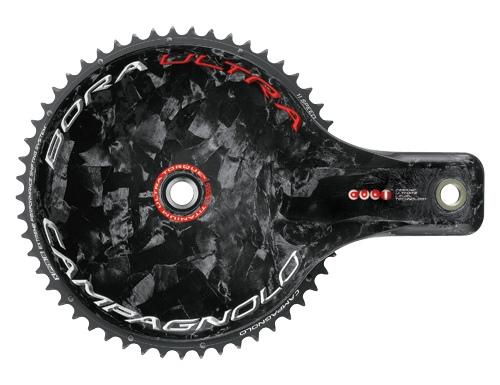
These aero cranks really remind me of Zipp’s now-discontinued Vuma Chrono, which was known for its stiffness and superb shift quality. With a huge carbon spider, there was almost no deflection under load. Campagnolo succeeds in one area in which Zipp failed, and that is chainring sizes; the Bullet goes down to compact 50/34 (Zipp’s minimum in the ‘Chrono was 53/39). Unfortunately, Campagnolo fails where Zipp succeeded – in length options. Campy’s shortest option in their fantastic aero crank is 170mm. A 165mm option would really improve Campy’s appeal in tri.
Campagnolo also has a high-tech shifter design, which they call Back to Zero. Similar to SRAM’s R2C, this brings the shifter back to the center position after the shift completes. Given my experience with Campy and my dislike of SRAM’s R2C, I would likely only choose this option if my bike was also equipped with the stiff Bora or Bullet crankset – to ensure the fastest possible shift.
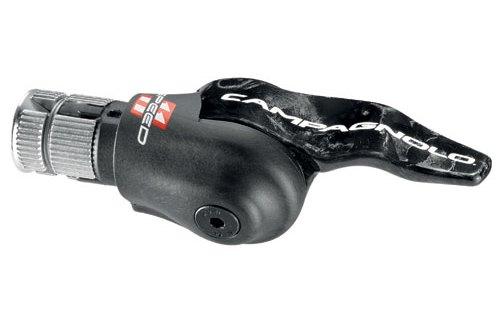
Front shifting – Other Brands
What about other brands aside from Shimano, SRAM, and Campagnolo? As with most things, the proof is in the pudding. When in doubt, ask your mechanic or take a test ride. I had terrible experience with older FSA chainrings, but their latest Metron aero crank blew me away with great shifts. We have reviewed aftermarket rings from Praxis Works and WickWerks, which both offer upgraded performance over most stock chainrings.
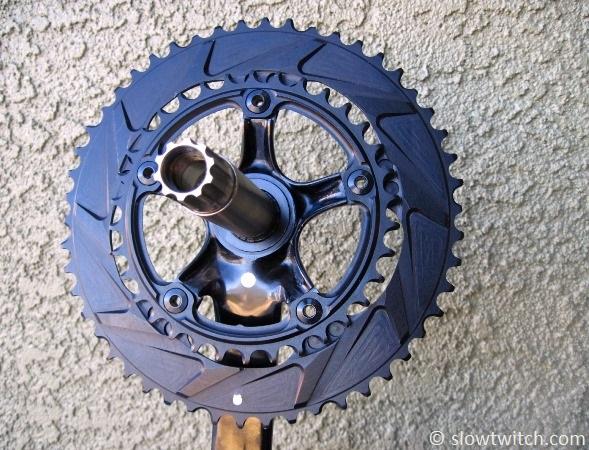
Having tried a huge number of odd combo drivetrains out there, I can tell you that the easiest way to improve your shifting with an off-brand chainring is to use a Shimano Ultegra 6700 or newer front derailleur, along with a chain from KMC, Rotor, or Shimano (Ultegra or better). While it is definitely possible to end up with a good shift using other parts, that derailleur and chain combo almost always does a bike good. If you’re on a tight budget and own a tri bike with Shimano Sora or Tiagra, for example, upgrading to WickWerks chainrings, an Ultegra front derailleur, and KMC chain will result in near Dura Ace performance for a fraction of the price. I have Rotor oval chainrings on my bike right now, and it shifts very well with this setup – on par with many high-end round chainrings.
Rear Shifting
Rear shifting is easier to execute than a front shift on-paper. With small jumps in cog size, it is harder to screw up. The difficult part with rear shifting isn’t so much fault of the derailleur, it’s the cable and housing that get contaminated. That final piece of housing is the recipient of an incredible amount of dirt, sweat, Gatorade, and other unmentionables.
That being said, the best medicine for any rear shifting system is a good cable and housing. Feel the shift effort when the cables have just been replaced; when the effort goes much higher or you start having odd shifting, it’s time for a replacement.
Shimano rear shifting
In my opinion, it is the rear shifting that improved in the latest iterations of Ultegra and Dura Ace. Everyone seems to be going gaga over the front shifting, yet ignores the rear. Yes, that is some great front shifting, but I honestly don’t think it improved over the 10-speed 6700 and 7900. They were fantastic before… and the new stuff is equally fantastic. I haven’t noticed any difference in incidence of overshift, slow shifts, dropped chains, or any other behavior between the 10 and 11-speed systems, regardless of chainring brand.
The rear shifting is now on another level. Specifically, Shimano did what I thought they never would, which is change from a floating upper pulley to a fixed upper pulley. In layman’s terms, the floating pulley design can move side-to-side a little bit, while the fixed pulley cannot.
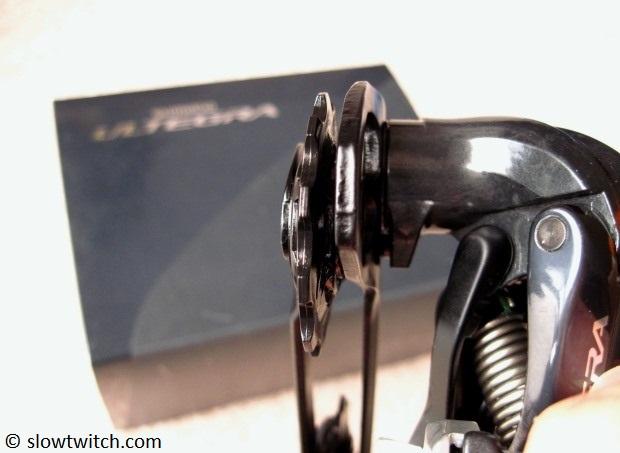
I always heard speculation from pro mechanics that Shimano’s whisper quiet performance was due to the floating pulley. The only negative consequence was that it could cause a little bit of sloppy feeling with bar-end shifters. When shifting to a smaller cog, it was not uncommon to 1) execute the shift downward, and 2) do a ‘quarter upshift’ tug on the right shift lever to make the drivetrain run quiet again. The derailleur and pulley don’t always center where you want on their own.
I have used both Ultegra 6800 and Dura Ace 9000 systems extensively, and they are both incredibly smooth and quiet. In addition, Shimano slightly increased the required effort to execute rear shifts, to a level that is above older 10-speed Shimano, but less than the super-firm SRAM TT900. It is, in my opinion, the best bar-end shifter and rear derailleur combo in existence. Now that Shimano has all of the cassette choices we need, I wouldn’t change anything about it.
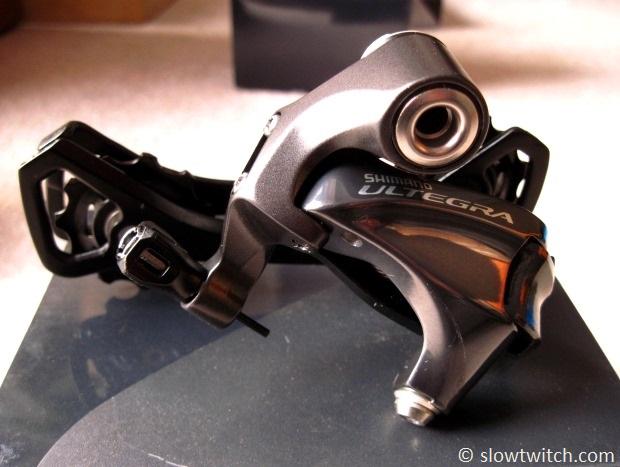
SRAM rear shifting
I have been a fan of SRAM rear shifting since their TT900 shifters came out. They have a high effort to shift, but you know when that shift happens. They’re light, inexpensive, and get the job done. Similar to my arguments with front shifting, I highly prefer the standard TT900 and 500 over the R2C shifters. The shift throw is shorter and more precise-feeling (not to mention, the shifters cost much less).
Until very recently, SRAM had the market cornered on rear shifting when it came to wide-range cassettes. Nobody else was doing a lot with 11-28, and nobody was doing 11-32 (outside of a few mish-mash setups, such as a 9-speed mountain rear derailleurs and IRD 11-32 cassettes). SRAM’s offering of a mid-cage road rear derailleur rocked our world, and for good reason.
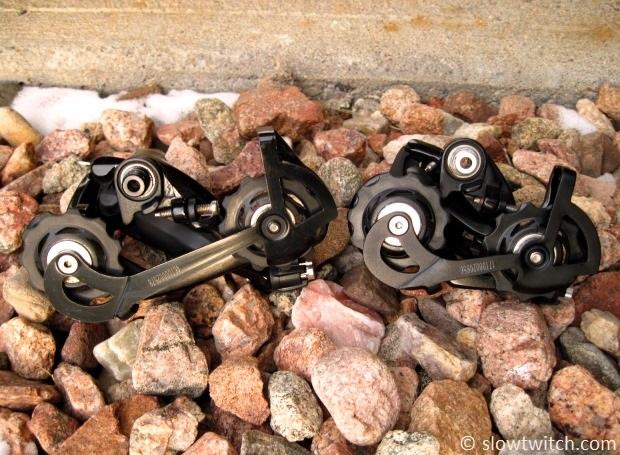
Now that drivetrains are hitting 11 speeds, these wide range cassettes no longer have unreasonably large ‘jumps’ in size between gears. Unfortunately, it will be at least several months before we can buy these systems from SRAM for our tri bikes, but it’s coming. The only electronic groupset to offer 11-32 compatibility is the brand-new (and expensive) Ultegra 6870 11-speed system with long-cage rear derailleur.
SRAM tends to win the weight war in most cases, with very light rear derailleurs and hollow cassettes. Original Red cassettes were criticized for being noisy, because they were noisy. Newer versions are drilled out to save weight, which also reduces noise when combined with their Stealth Ring technology (little rubber bands sit in-between each cog).
Campagnolo rear shifting
Campagnolo bar-end shifting has never left any significant impression in my brain – positive or negative. My old 10-speed bar-ends got the mechanic’s A+ award for having a tiny little barrel adjuster integrated right into the lever. I loved them. Similar to some of the older Shimano components, I tended to get some noise when shifting down into smaller cogs, requiring a slight lift on the lever to make it quiet again. The most important thing for good Campy rear shift performance always seemed to be using their own chain. Other brands never seemed to do quite as well.
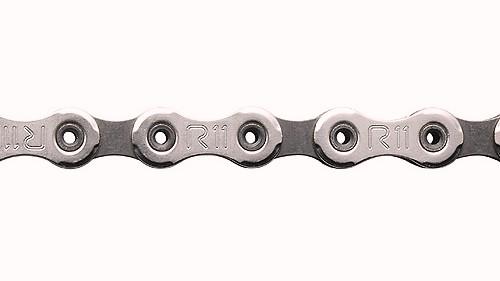
Campy now offers up to an 11-27 cassette, but nothing larger than that unless you want a 12-tooth small cog. While this is a clear step forward for the Italian brand, almost every triathlete I speak with wants that 11-tooth cog. If you need large cogs for going uphill, you want the 11 for going back down the hill. In addition, use of compact 50/34 chainrings greatly increase the likelihood that you will need to use your smallest cog out back.
Take-Homes
Is mechanical shifting still relevant in triathlon? In my opinion, the answer is yes, with a few things to consider.
First, due to price, mechanical will always play a role. Things will have to change significantly with electronic components for the price to come down to entry-level bikes.
Next, until the last few years, almost every bike frame was made for mechanical components, not electronic. While you can ‘make’ electronic work on a mechanical-style frame, it never looks good and is a big mess of exposed wires. Most new frames support both mechanical and electronic, and this is the way forward.
Finally, there are still very few options for wide-range 11-32 cassettes in electronic, giving a big nod to mechanical – at least as of 2014.
When it comes to optimizing mechanical shifting for triathlon, shift quality and speed are of paramount importance. When cruising on the base bar, you want to be able to shift as quickly as possible, so your hands can get back to your brake levers. Regular maintenance and quality parts go a long way to making your mechanical drivetrain perform in tip-top shape.



